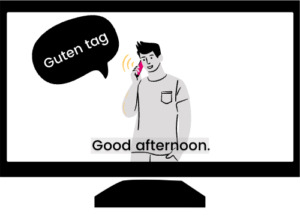What are Forced Subtitles?
Updated: February 15, 2023
Download the [FREE] Checklist: Dubbing
We previously covered SDH subtitles, non-SDH subtitles, and when they’re used; the difference between SDH subtitles and closed captions; and how subtitles vary from closed captions in general. That leaves us a common yet important subtitle type that most viewers never actually have to toggle on: forced narrative subtitles.
A number of subtitling types exist in the world of video translation and localization services. The most commonly used subtitles include:
- Subtitles for the Deaf and Hard of Hearing (SDH)
- non-Subtitles for the Deaf and Hard of Hearing (non-SDH)
- Forced Narrative (FN)
Forced narrative subtitles are crucial to supporting audience comprehension in a number of programs, regardless of the genre. So why is that? In this blog, we’ll explore what forced narrative subtitles are, what they look like, and when to use them.
What are Forced Subtitles, and What Purpose Do They Serve?
Forced narrative (FN) subtitles, sometimes referred to as forced subtitles, are used to clarify pertinent information meant to be understood by the viewer. FN subtitles are overlaid text used to clarify dialogue, burned-in texted graphics, and other information that is not otherwise explained or easily understood by the viewer. Forced narrative subtitles are typically used in video translation and localization workflows to ensure any viewer can understand critical textual elements displayed on screen.
Forced narrative subtitles broaden the viewing experience across a wide range of countries, languages, and devices. FN subtitles are delivered as separate timed text files; therefore, they are not burned into the video.
A full subtitle file translates the entirety of a program’s content, but must be toggled on by the viewer. It may or may not contain forced narrative content, depending on the viewing platform and other factors, such as timing. This means that information contained in a forced narrative, like the translation of a sign or other on-screen text that is normally not translated in full subtitle files, may not be included if dialogue is happening at the same time as the other text is displayed. Dialogue translation takes precedence over forced narrative elements in these cases.
What Do Forced Subtitles Look Like?
Many OTT providers will not display forced subtitles unless the Subtitles/CC settings are set to “off.” That being said, some platforms, like Netflix, incorporate forced narrative content into full subtitling and closed caption files.
When forced narrative subtitles are displayed on their own, their appearance can mirror that of typical subtitling or closed captioning files. And much like subtitles and captions, the visual appearance of FN subtitles varies depending on the platform, player, television, or other viewing device.
Adding dubbing or voice-over to your video? This checklist covers everything you need to consider 💬
How Are Forced Subtitles Used?
Forced narrative subtitles are commonly used in several scenarios. Let’s explore these different use cases for FN subtitles to better understand what they are and how they work.
Sporadic Foreign Language
Although a film may be in one source language, occasionally certain characters will use a phrase or short segment of a different language.
One scenario might be a German character living in the United States who makes a phone call to a family member where they speak in German. If the information during this scene is important to the plot and overall understanding of the movie or show, FN subtitles will be used to translate the conversation.
Translation of Labels
Sometimes burned-in text graphics are used to enhance the viewing experience. Oftentimes, these are labels for locations, names, or dates. Since they are burned into the video in the original language, FN subtitles can be used to translate these into another language for viewers.
This image showcases an example of a film containing a location label in the original language at the top. When shown in the United States, English FN subtitles would be used to translate the city name for English-speaking viewers to understand.
Other Forms of Communication
Forced narrative subtitles are helpful in cases where other forms of communication are showcased in a video, such as non-verbal communication formats like sign language; or fictional languages, such as Game of Thrones’ Dothraki or Elvish dialects in Lord of the Rings.
For example, if a character communicates in sign language, forced narrative subtitles would be used to clarify the meaning for viewers who aren’t familiar with the language. This example shows forced narrative subtitles below a teacher communicating via sign language.
Transcribed Dialogue
Sometimes forced narrative subtitles are used for transcribed dialogue in the same language. This is done to assist audience members when audio is inaudible or distorted.
It may be hard to hear dialogue in an action movie with a lot of background noise, or in a documentary with poor audio quality. In either of these cases, FN subtitles could be used to clarify dialogue for the viewer.
Forced Narrative Subtitling with 3Play Media
Did you know 3Play Media creates forced narrative subtitles for video content?
Our experienced translation and subtitling team creates forced narrative subtitles for video content across networks and major OTT platforms. View our plans, and get in touch with 3Play Media to get started!
Not sure if you need forced narrative subtitles?
We’re here to help. Our team is filled with experienced localization professionals who have created countless SDH, non-SDH, and FN subtitling files for a variety of networks and streaming platforms. Reach out to begin scoping your project, and we’ll help determine if forced narrative subtitling is right for your content.
This blog was originally published by Elisa Lewis on December 8, 2017, as “What Are Forced Narrative Subtitles?” and has since been updated for comprehensiveness, clarity, and accuracy.










